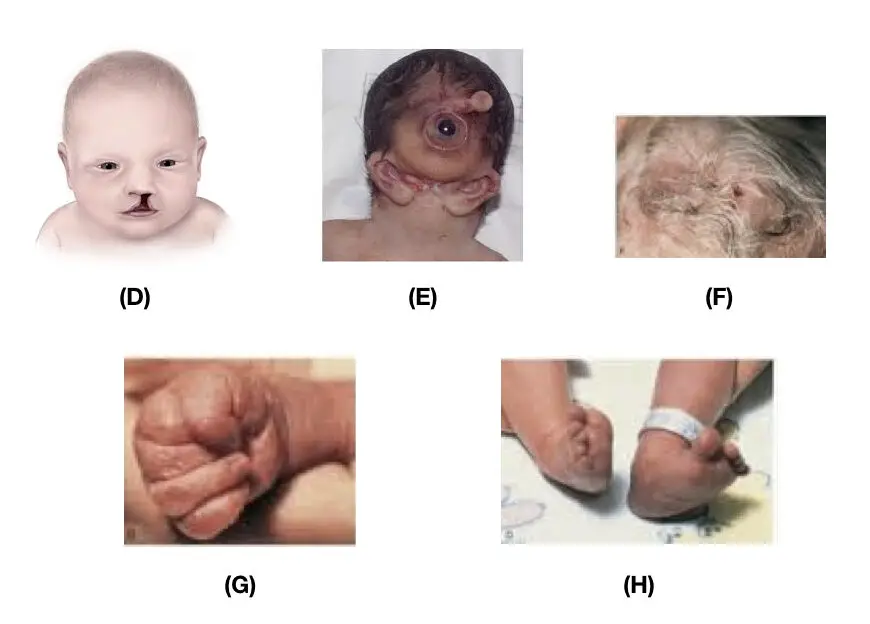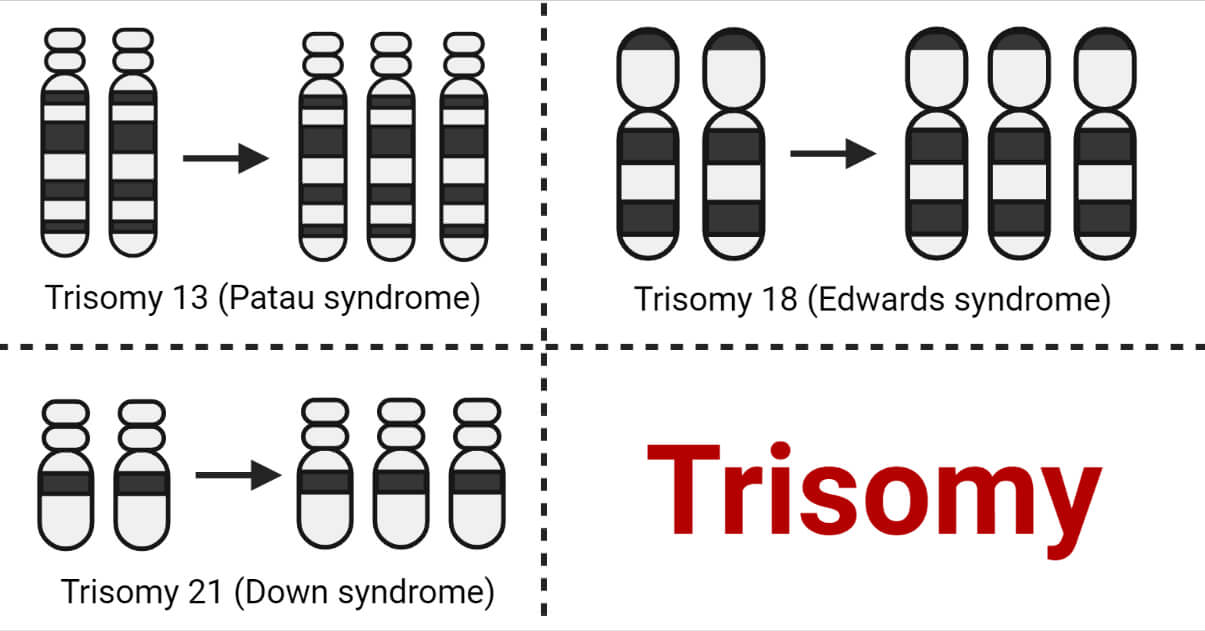Nursing Paper Example on Trisomy
Nursing Paper Example on Trisomy
(Nursing Paper Example on Trisomy) Trisomy refers to a chromosomal abnormality characterized by the presence of an extra chromosome in cells. In typical human cells, chromosomes are present in pairs, giving 46 chromosomes in total. However, in trisomy, there are 47 chromosomes due to an additional copy of one chromosome. This extra chromosome leads to various physical and cognitive abnormalities depending on which chromosome is affected. Some of the most recognized forms of trisomy include Trisomy 21 (Down syndrome), Trisomy 18 (Edwards syndrome), and Trisomy 13 (Patau syndrome). Each of these conditions manifests differently, requiring unique approaches to diagnosis, management, and care.

Types of Trisomy and Causes
Trisomy can affect any of the 23 pairs of chromosomes, though only a few types result in viable births.
- Common Types of Trisomy:
-
- Trisomy 21 (Down Syndrome): The most common type of trisomy, characterized by an additional copy of chromosome 21. It occurs in approximately 1 in 700 live births (Centers for Disease Control and Prevention [CDC], 2023).
- Trisomy 18 (Edwards Syndrome): In this condition, there is an extra chromosome 18, and it occurs in approximately 1 in 5,000 live births. It has high rates of mortality within the first year.
- Trisomy 13 (Patau Syndrome): This condition involves an extra chromosome 13 and is seen in about 1 in 10,000 births. It is associated with severe neurological and physical abnormalities.

2. Causes and Risk Factors:
-
- Nondisjunction: The primary cause of trisomy is a process called nondisjunction, where chromosomes fail to separate correctly during cell division, resulting in a gamete with an extra chromosome.
- Advanced Maternal Age: Women over the age of 35 have a higher risk of having a baby with trisomy. Age-related changes in the body can increase the risk of errors during meiosis, the process of forming gametes.
- Genetic Mutations: Although rare, some familial mutations or translocations can increase the risk of trisomy in offspring (National Institutes of Health [NIH], 2023).
Signs and Symptoms of Trisomy Disorders
The clinical manifestations of trisomy vary depending on the chromosome involved. Each type of trisomy presents distinct signs, often detectable at birth.
- Down Syndrome (Trisomy 21):
- Physical Characteristics: Low muscle tone, flat facial profile, and upward slanting eyes are common features.
- Developmental Delays: Many individuals with Down syndrome have delayed cognitive and motor skill development.
- Health Complications: There is an increased risk of heart defects, respiratory issues, and thyroid abnormalities (Mayo Clinic, 2023).
- Edwards Syndrome (Trisomy 18):
- Distinctive Physical Features: Small head size, low-set ears, and overlapping fingers.
- Severe Developmental Delays: Infants with Trisomy 18 have profound cognitive and physical disabilities.
- Shortened Life Expectancy: Due to severe complications, including heart defects, survival beyond infancy is rare.
- Patau Syndrome (Trisomy 13):
- Physical Abnormalities: Cleft lip or palate, extra digits (polydactyly), and neural tube defects.
- Severe Developmental Impairment: Intellectual disability is profound, and many infants do not survive beyond the first weeks of life.
- Multiple System Involvement: Heart, kidney, and neurological abnormalities are common (Johns Hopkins Medicine, 2023).
Pathophysiology of Trisomy
Trisomy arises from chromosomal nondisjunction, leading to an extra chromosome that affects cellular processes in multiple ways.
- Chromosomal Mechanism: During the formation of eggs or sperm, chromosomes should evenly separate. In nondisjunction, this separation fails, and an extra chromosome is passed to the embryo.
- Gene Overexpression: The additional chromosome leads to the overexpression of genes, which disrupts normal cellular functions. This disruption contributes to the physical, neurological, and developmental abnormalities observed.
- Mosaic Trisomy: In some cases, the extra chromosome is not present in every cell, leading to mosaic trisomy. The severity of symptoms can vary based on the proportion of cells affected (World Health Organization [WHO], 2023).
Diagnosis of Trisomy Disorders
Diagnosis of trisomy disorders occurs through prenatal screening and confirmatory testing.
- Prenatal Screening:
- Ultrasound: An ultrasound can detect markers such as increased nuchal translucency in fetuses with Down syndrome.
- Blood Tests: Maternal blood tests like cell-free DNA testing can identify trisomy risk with high accuracy. These tests detect fetal DNA in maternal blood to estimate the probability of chromosomal abnormalities.
- Confirmatory Tests:
- Amniocentesis: In this test, a sample of amniotic fluid is collected and analyzed for chromosomal abnormalities.
- Chorionic Villus Sampling (CVS): CVS involves taking a sample of placental tissue to examine the chromosomes.
- Karyotyping: This process involves visualizing chromosomes under a microscope to confirm the presence of an extra chromosome (Mayo Clinic, 2023).
Management and Treatment of Trisomy Disorders
While trisomy disorders have no cure, management focuses on symptom relief, developmental support, and medical care for associated health issues.
- Medical Treatment:
- Heart Defects: Many children with Down syndrome and other trisomies may require surgery for congenital heart defects.
- Gastrointestinal Support: Individuals with trisomy may experience digestive issues that require dietary adjustments and sometimes surgical interventions.
- Specialized Care: Medical teams often include cardiologists, neurologists, and developmental specialists to address the multifaceted needs of individuals with trisomy (CDC, 2023).
- Developmental Support:
- Speech and Physical Therapy: Many individuals benefit from therapies to improve speech, motor skills, and cognitive function.
- Education and Social Inclusion: Early intervention programs and inclusive education help maximize developmental potential.
- Support for Families: Resources such as counseling and support groups can assist families in managing the unique challenges of raising a child with trisomy (WHO, 2023).
(Nursing Paper Example on Trisomy)
Prevention and Genetic Counseling
Although trisomy is largely a random genetic occurrence, certain steps can reduce risks and support families.
- Genetic Counseling: Couples with a family history of chromosomal abnormalities or previous affected pregnancies should seek genetic counseling. Counselors can provide insights into the risk of recurrence and guide family planning.
- Maternal Age Consideration: Women over 35 should discuss screening options with their healthcare provider to monitor for potential chromosomal abnormalities in pregnancies.
- Awareness and Education: Public health campaigns can inform women about age-related risks, and encourage early prenatal care and screening (NIH, 2023).
Complications Associated with Trisomy Disorders
The complications of trisomy extend beyond developmental delays, impacting multiple organ systems and overall life expectancy.
- Reduced Life Expectancy: Severe forms like Edwards syndrome and Patau syndrome often lead to death in infancy due to extensive organ involvement.
- Increased Susceptibility to Illness: People with Down syndrome may experience immune deficiencies, making them more susceptible to infections.
- Risk of Leukemia: Individuals with Down syndrome have a higher risk of developing certain blood cancers, particularly leukemia.
Conclusion
Trisomy represents a group of genetic disorders characterized by the presence of an additional chromosome. While trisomy disorders like Down syndrome, Edwards syndrome, and Patau syndrome affect individuals differently, they share common challenges, including developmental delays, physical abnormalities, and health complications. Through early diagnosis, multidisciplinary medical care, and social support, individuals with trisomy can live fulfilling lives. Advances in prenatal screening and genetic counseling have also made it possible for families to make informed choices about trisomy risks and potential interventions.
References
Centers for Disease Control and Prevention. (2023). Trisomy and Genetic Disorders: Information and Support. https://www.cdc.gov
Johns Hopkins Medicine. (2023). Trisomy Disorders: Diagnosis and Treatment Options. https://www.hopkinsmedicine.org
Mayo Clinic. (2023). Chromosomal Disorders and Trisomy: Health Implications. https://www.mayoclinic.org
National Institutes of Health. (2023). Understanding Trisomy and Chromosomal Abnormalities. https://www.nih.gov
World Health Organization. (2023). Genetic Conditions and Trisomy: Global Health Perspective. https://www.who.int


